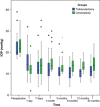Trabeculectomy versus canaloplasty (TVC study) in the treatment of patients with open-angle glaucoma: a prospective randomized clinical trial
- PMID: 25847610
- PMCID: PMC6680218
- DOI: 10.1111/aos.12722
Trabeculectomy versus canaloplasty (TVC study) in the treatment of patients with open-angle glaucoma: a prospective randomized clinical trial
Abstract
Purpose: To compare the outcomes of canaloplasty and trabeculectomy in open-angle glaucoma.
Methods: This prospective, randomized clinical trial included 62 patients who randomly received trabeculectomy (n = 32) or canaloplasty (n = 30) and were followed up prospectively for 2 years. Primary endpoint was complete (without medication) and qualified success (with or without medication) defined as an intraocular pressure (IOP) of ≤18 mmHg (definition 1) or IOP ≤21 mmHg and ≥20% IOP reduction (definition 2), IOP ≥5 mmHg, no vision loss and no further glaucoma surgery. Secondary endpoints were the absolute IOP reduction, visual acuity, medication, complications and second surgeries.
Results: Surgical treatment significantly reduced IOP in both groups (p < 0.001). Complete success was achieved in 74.2% and 39.1% (definition 1, p = 0.01), and 67.7% and 39.1% (definition 2, p = 0.04) after 2 years in the trabeculectomy and canaloplasty group, respectively. Mean absolute IOP reduction was 10.8 ± 6.9 mmHg in the trabeculectomy and 9.3 ± 5.7 mmHg in the canaloplasty group after 2 years (p = 0.47). Mean IOP was 11.5 ± 3.4 mmHg in the trabeculectomy and 14.4 ± 4.2 mmHg in the canaloplasty group after 2 years. Following trabeculectomy, complications were more frequent including hypotony (37.5%), choroidal detachment (12.5%) and elevated IOP (25.0%).
Conclusions: Trabeculectomy is associated with a stronger IOP reduction and less need for medication at the cost of a higher rate of complications. If target pressure is attainable by moderate IOP reduction, canaloplasty may be considered for its relative ease of postoperative care and lack of complications.
Keywords: canaloplasty; glaucoma surgery; open-angle glaucoma; trabeculectomy.
© 2015 The Authors. Acta Ophthalmologica published by John Wiley & Sons Ltd on behalf of Acta Ophthalmologica Scandinavica Foundation.
Figures



Similar articles
-
Long-term outcomes of trabeculectomy versus canaloplasty in open-angle glaucoma - an 11-year follow-up of the TVC study cohort.BMC Ophthalmol. 2025 Jun 16;25(1):340. doi: 10.1186/s12886-025-04183-9. BMC Ophthalmol. 2025. PMID: 40524153 Free PMC article. Clinical Trial.
-
Comparison of surgical outcomes between canaloplasty and trabeculectomy with mitomycin C at 2-year follow-up: A longitudinal cohort study.Indian J Ophthalmol. 2018 Jan;66(1):66-70. doi: 10.4103/ijo.IJO_543_17. Indian J Ophthalmol. 2018. PMID: 29283126 Free PMC article.
-
Comparison of surgical outcomes between canaloplasty and trabeculectomy at 12 months' follow-up.Ophthalmology. 2011 Dec;118(12):2427-33. doi: 10.1016/j.ophtha.2011.05.021. Ophthalmology. 2011. PMID: 21856008
-
[Trabeculectomy versus canaloplasty].Ophthalmologe. 2015 Apr;112(4):325-31. doi: 10.1007/s00347-014-3160-7. Ophthalmologe. 2015. PMID: 25712418 Review. German.
-
Comparative outcomes between newer and older surgeries for glaucoma.Trans Am Ophthalmol Soc. 2009 Dec;107:127-33. Trans Am Ophthalmol Soc. 2009. PMID: 20126489 Free PMC article. Review.
Cited by
-
Canaloplasty: Current Value in the Management of Glaucoma.J Ophthalmol. 2016;2016:7080475. doi: 10.1155/2016/7080475. Epub 2016 Apr 30. J Ophthalmol. 2016. PMID: 27239337 Free PMC article. Review.
-
Evaluation of the Efficacy and Safety of Canaloplasty and iStent Bypass Implantation in Patients with Open-Angle Glaucoma: A Review of the Literature.J Clin Med. 2021 Oct 23;10(21):4881. doi: 10.3390/jcm10214881. J Clin Med. 2021. PMID: 34768400 Free PMC article. Review.
-
Advances in Canaloplasty-Modified Techniques Yield Strong Pressure Reduction with Low Risk Profile.J Clin Med. 2023 Apr 21;12(8):3031. doi: 10.3390/jcm12083031. J Clin Med. 2023. PMID: 37109367 Free PMC article. Review.
-
[Comparison of trabeculectomy and canaloplasty : Pressure reducing effect and postoperative interventions/complications].Ophthalmologe. 2018 Feb;115(2):137-144. doi: 10.1007/s00347-017-0449-3. Ophthalmologe. 2018. PMID: 28210791 German.
-
Safety and Efficacy of Three Variants of Canaloplasty with Phacoemulsification to Treat Open-Angle Glaucoma and Cataract: 12-Month Follow-Up.J Clin Med. 2022 Nov 2;11(21):6501. doi: 10.3390/jcm11216501. J Clin Med. 2022. PMID: 36362728 Free PMC article.
References
-
- Arthur SN, Cantor LB, Wudunn D, Pattar GR, Catoira‐Boyle Y, Morgan LS & Hoop JS (2013): Efficacy, safety, and survival rates of IOP‐lowering effect of phacoemulsification alone or combined with canaloplasty in glaucoma patients. J Glaucoma 23: 316–320. - PubMed
-
- Ayyala RS, Chaudhry AL, Okogbaa CB & Zurakowski D (2011): Comparison of surgical outcomes between canaloplasty and trabeculectomy at 12 months' follow‐up. Ophthalmology 118: 2427–2433. - PubMed
-
- Barnebey HS (2013): Canaloplasty with intraoperative low dosage mitomycin C: a retrospective case series. J Glaucoma 22: 201–204. - PubMed
-
- Bettin P & Di Matteo F (2013): Glaucoma: present challenges and future trends. Ophthalmic Res 50: 197–208. - PubMed
-
- Bruggemann A, Despouy JT, Wegent A & Muller M (2013): Intraindividual comparison of canaloplasty versus trabeculectomy with mitomycin C in a single‐surgeon series. J Glaucoma 22: 577–583. - PubMed
Publication types
MeSH terms
LinkOut - more resources
Full Text Sources
Other Literature Sources

